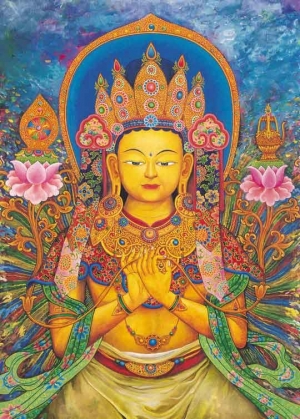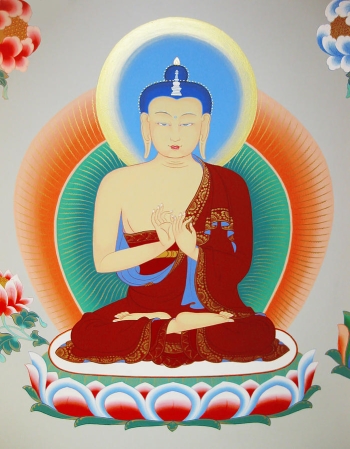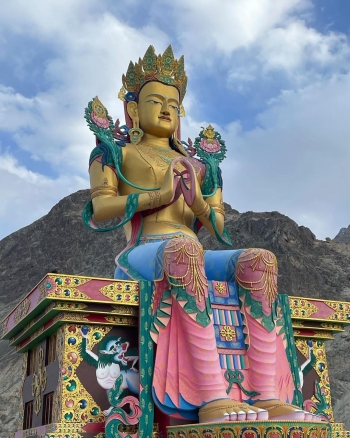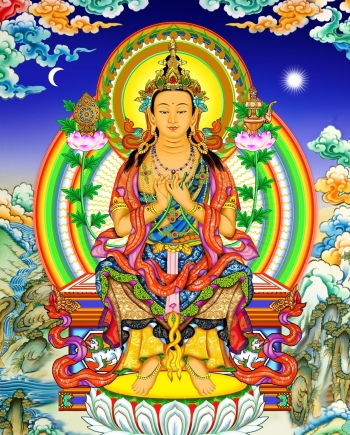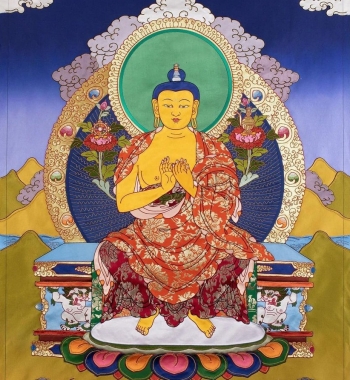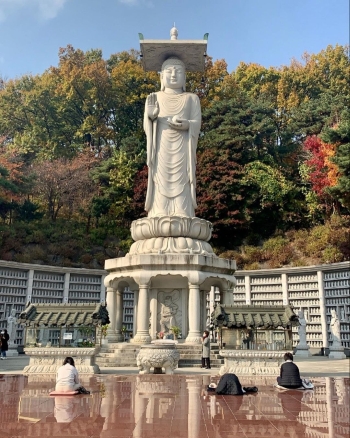Maitreya - Future Buddha
1. Maitreya
Maitreya (Sanskrit) or Metteyya (Pāḷi) is regarded as a Future Buddha of this world in Buddhist eschatology.
In some Buddhist literature, such as the Amitābha Sūtra and the Lotus Sūtra, the being is referred to as Ajita.
According to Buddhist tradition, Maitreya is a Bodhisattva who will appear on Earth in the future, achieve complete Enlightenment, and teach the Pure Dharma.
According to scriptures, Maitreya will be a successor to the present Buddha, Gautama Buddha (also known as Śākyamuni Buddha).
The prophecy of the arrival of Maitreya refers to a time in the future when the dharma will have been forgotten by most on the terrestrial world.
Maitreya has also been employed in a millenarian role by many non-Buddhist religions in the past, such as Theosophy, the White Lotus, as well as by modern new religious movements, such as Yiguandao.
2. Sources
The name Maitreya is derived from the Sanskrit word Maitrī "friendship", which is in turn derived from the noun Mitra "friend".
The Pāḷi form Metteyya is mentioned in the Cakkavatti-Sīhanāda Sutta (Dīgha Nikāya 26) of the Pāli Canon, and also in chapter 28 of the Buddhavaṁsa.
Cakkavatti-Sīhanāda Sutta says:
… there will arise in the world a Blessed Lord, an Arahant fully-enlightened Buddha named Metteyya,…
He will teach the Dhamma, lovely in its beginning, lovely in its middle, lovely in its ending, in the spirit and in the letter, and proclaim, just as I do now, the holy life in its fullness and purity.
He will be attended by a company of thousands of monks, just as I am attended by a company of hundreds.
Cakkavatti-Sīhanāda Sutta (DN 26)
Most of the Buddha's sermons are presented as having been presented in answer to a question, or in some other appropriate context, but this Sutta has a beginning and ending in which the Buddha is talking to monks about something totally different.
In the Greco-Buddhist art of Gandhara, in the first centuries CE in northern India, Maitreya was the most popular figure to be represented along with Gautama Buddha (often called Śākyamuni "sage of the Shakya").
In 4-6th-century China, “Buddhist artisans used the names Śākyamuni and Maitreya interchangeably... indicating both that the distinction between the two had not yet been drawn and that their respective iconographies had not yet been firmly set”.
An example is the stone sculpture found in the Qingzhou dedicated to Maitreya in 529 CE as recorded in the inscription (currently in the Qingzhou Museum, Shandong).
The religious belief of Maitreya apparently developed around the same time as that of Amitābha, as early as the 3rd century CE.
3. Characteristics
One mention of the prophecy of Maitreya is in the Maitreya-Vyākaraṇa. It implies that he is a teacher of meditative trance Sādhana and states that gods, men and other beings:
Will lose their doubts, and the torrents of their cravings will be cut off:
free from all misery they will manage to cross the ocean of becoming; and, as a result of Maitreya's teachings, they will lead a holy life.
No longer will they regard anything as their own, they will have no possession, no gold or silver, no home, no relatives! But they will lead the holy life of oneness under Maitreya's guidance.
They will have torn the net of the passions, they will manage to enter into trances, and theirs will be an abundance of joy and happiness, for they will lead a holy life under Maitreya's guidance.
Maitreya-Vyākaraṇa
4. General description
Maitreya is typically pictured seated, with either both feet on the ground or crossed at the ankles, on a throne, waiting for his time.
He is dressed in the clothes of either a bhikṣu (monk) or Indian royalty. As a Bodhisattva, he would usually be standing and dressed in jewels.
Usually he wears a small Stūpa in his headdress that represents the Stūpa with relics of Gautama Buddha to help him identify it when his turn comes to lay claim to his succession, and can be holding a Dharmacakra resting on a lotus.
A khata scarf is always tied around his waist as a girdle.
In the Greco-Buddhist art of Gandhara, Maitreya is represented as a northern Indian nobleman, holding a Kumbha in his left hand. Sometimes this is a "wisdom urn" (Tibetan: Bumpa).
He is flanked by his 2 acolytes, the brothers Asaṅga and Vasubandhu, who founded the Yogācāra tradition.
5. Maitreya's Tuṣita Heaven
Maitreya currently resides in the Tuṣita Heaven (Pāli: Tuṣita), said to be reachable through meditation.
Gautama Buddha also lived here before he was born into the world as all Bodhisattvas live in the Tuṣita Heaven before they descend to the human realm to become Buddhas.
Although all Bodhisattvas are destined to become Buddhas, the concept of a Bodhisattva differs greatly in Theravāda and Mahāyāna Buddhism:
In Theravāda Buddhism, a Bodhisattva is one who is striving for full enlightenment (Arahantship in Pāḷi),
whereas in Mahāyāna Buddhism, a Bodhisattva is one who has already reached a very advanced state of grace or enlightenment but holds back from entering Nirvāṇa so that he may help others.
In Mahāyāna Buddhism, Buddhas preside over Pure Lands, such as Amitābha over Sukhāvatī:
Once Maitreya becomes a Buddha, he will rule over the Ketumatī Pure Land, an Earthly Paradise sometimes associated with the city of Varanasi (also known as Benares) in Uttar Pradesh, India, and in other descriptions, the Śambhala.
In Theravāda Buddhism, Buddhas are born as Unenlightened Humans, and are not rulers of any paradise or Pure Land:
Maitreya's arising would be no different from the arising of Gautama Buddha, as he achieved full Enlightenment as a human being and died, entering Parinibbāna (Nirvāṇa-after-death).
6. Activity of Maitreya in the current age
In Mahāyāna schools, Maitreya is traditionally said to have revealed the 5 Treatises of Maitreya through Asaṅga.
These texts are the basis of the Yogācāra tradition and constitute the majority of the 3rd turning within the 3 Turnings of the Wheel of Dharma.
7. Future coming of Maitreya
According to Buddhist tradition, each Kalpa has 1 000 Buddhas.
The previous Kalpa was the Vyūha Kalpa (Glorious aeon), and the present Kalpa is called the Bhadrā Kalpa (Auspicious aeon).
The 7 Buddhas of Antiquity (Sapta Tathāgata) are 7 Buddhas which bridge the Vyūha Kalpa and the Bhadrā Kalpa:
- Vipassī (the 998th Buddha of the Vyūha Kalpa)
- Sikhī (the 999th Buddha of the Vyūha Kalpa)
- Vessabhū (the 1000th and final Buddha of the Vyūha Kalpa)
- Kakusandha (the 1st Buddha of the Bhadra Kalpa)
- Koṇāgamana (the 2nd Buddha of the Bhadra Kalpa)
- Kassapa (the 3rd Buddha of the Bhadra Kalpa)
- Gautama (the 4th and present Buddha of the Bhadra Kalpa)
Maitreya will be the 5th and future Buddha of the Bhadrā Kalpa, and his arrival will occur after the teachings of Gautama Buddha are no longer practiced.
The coming of Maitreya will be characterized by a number of physical events. The oceans are predicted to decrease in size, allowing Maitreya to traverse them freely.
Maitreya will then reintroduce true dharma to the world.
His arrival will signify the end of the Middle Time, the time between the 4th Buddha, Gautama Buddha, and the 5th Buddha, Maitreya, which is viewed as a low point of human existence.
According to the Cakkavatti Sutta: The Wheel-turning Emperor, Dīgha Nikāya 26 of the Sutta Piṭaka of the Pāli Canon,
Maitreya Buddha will be born in a time when humans will live to an age of 80 thousand years, in the city of Ketumatī (present Varanasi), whose king will be the Cakkavatti Śaṅkha.
Then King Śaṅkha will re-erect the palace once built by King Mahā-Panāda and, having lived in it, will give it up and present it to the ascetics and Brahmins, the beggars, the wayfarers, the destitute.
Then, shaving off hair and beard, he will don yellow robes and go forth from the household life into homelessness under the supreme Buddha Metteyya.
Cakkavatti Sutta (DN 26)
The scriptures say that Maitreya will attain Bodhi in 7 days (which is the minimum period), by virtue of his many lives of preparation for Buddhahood similar to those reported in the Jātaka tales.
At this time a notable teaching he will start giving is that of the 10 non-virtuous deeds (killing, stealing, sexual misconduct, lying, divisive speech, abusive speech, idle speech, covetousness, harmful intent and wrong views)
and the 10 virtuous deeds (the abandonment of: killing, stealing, sexual misconduct, lying, divisive speech, abusive speech, idle speech, covetousness, harmful intent and wrong views).
The Ārya Maitreya Maṇḍala, an Order founded by Anagārika Govinda, is based on the idea of the future coming of Maitreya.
Buddhist texts from several traditions say that beings in Maitreya's time will be much bigger than during the time of Śākyamuni:
In one prophecy his disciples are contemptuous of Mahākāśyapa, whose head is no larger than an insect to them. Buddha's robe barely covers 2 fingers making them wonder how tiny Buddha was. Mahākāśyapa is said to be small enough in comparison to cremate in the palm of Maitreya's hand.
8. Foretold biography
Maitreya will be born to the Brahmins, Tubrahmā (father) and Brahmavādī (mother) in Ketumatī, which will be ruled by King Śaṅkha, a Chakravartīn.
Maitreya's spouse will be Princess Sandamukkhī. His son will be Brahmavaṁsa.
After the birth of his son, Maitreya will leave to practice asceticism. He will practice for 7 days. After the practice, he will be awakened under a Ceylon ironwood tree.
The disciples of Maitreya Buddha are:
- Aśoka, a Chief Disciple and the right-hand chief disciple
- Brahmadeva, a Chief Disciple and the left-hand chief disciple
- Sumana, the right-hand Chief Nun
- Padumā, the left-hand Chief Nun
- Sīha, a primary attendant.
Maitreya will be 88 cubits (132 feet, 40 meters) tall and will live for 88 000 years. Like Maṅgala Buddha, his rays will make people hard to distinguish between day and night. His teachings will preserve for the next 180 000 years.
9. Nichiren Buddhism and Maitreya as metaphor
According to the Lotus Sūtra in Nichiren Buddhism, all people possess the potential to reveal an innate Buddha Nature during their own lifetimes, a concept which may appear to contradict the idea of Buddha as saviour or messiah.
Although Maitreya is a significant figure in the Lotus Sūtra, the explanation of Nichiren is that Maitreya is a metaphor of stewardship and aid for the Bodhisattvas of the Earth, as said in the Lotus Sūtra:
Moreover... all the Bodhisattvas, Bodhisattva Maitreya... will guard and protect the votaries of the Lotus Sūtra, so one may indeed rest assured.
Nichiren
In much of his writing, Nichiren mentions the traditional Buddhist views on Maitreya but explains that the propagation of the Eternal Dharma of the Lotus Sūtra was entrusted by Śākyamuni to the Bodhisattvas of Earth:
The Buddha did not entrust these 5 characters to Maitreya, Medicine King, or the others of their group. Instead he summoned forth the Bodhisattvas... from the great earth of Tranquil Light and transferred the 5 characters to them.
Nichiren
Thus, each individual can embody the character of the Maitreya because he is a metaphor for compassion:
The name Maitreya means ‘Compassionate One’ and designates the Votaries of the Lotus Sūtra.
Nichiren
